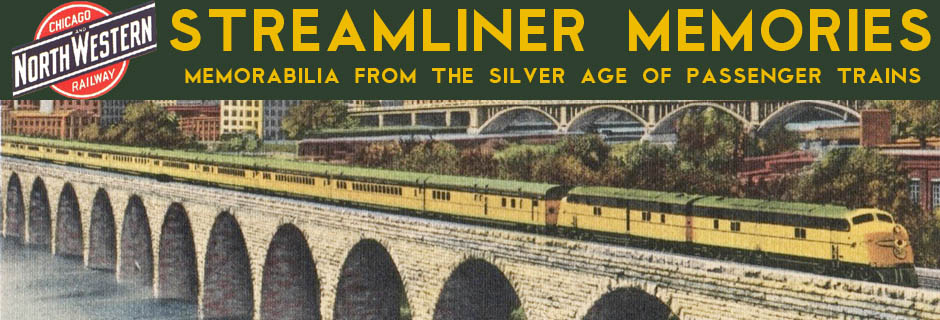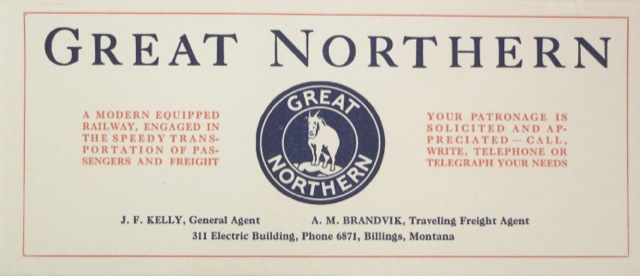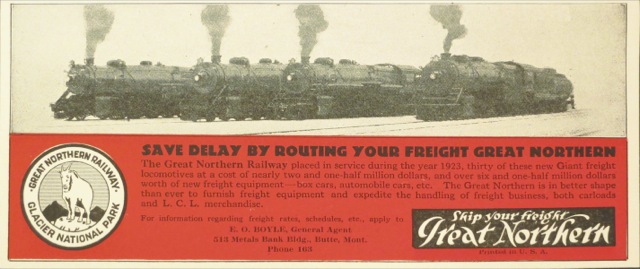After the introduction of the Empire Builder in 1929, the Oriental Limited became the Great Northern’s secondary transcontinental train. Until then, the secondary train was called the Glacier Park Limited. This 1924 blotter (an identical one was issued in 1925) notes that the train went from St. Paul to Seattle, indicating it did not have through cars continuing to or from Chicago. In fact, according to the 1928 timetable, while the westbound train connected with CB&Q train 51 from Chicago, the eastbound train connected with C&NW train 510 to Chicago, suggesting that GN’s Burlington subsidiary didn’t even think the Glacier Park Limited was important enough to have an eastbound connection.
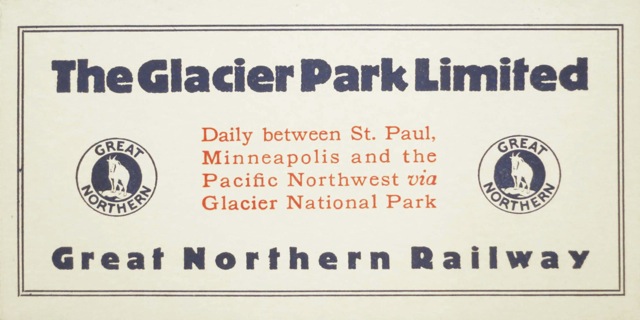
Click images to download PDFs of these blotters, which are 0.2 to 0.6 MB in size.
Like the Oriental Limited, the Glacier Park Limited had Pullmans, coaches, a first-class coach and smoking car, tourist sleepers, a diner, and an observation car. Unlike the premiere train, the Glacier Park Limited‘s observation car was half sleeping rooms, while the Oriental Limited devoted that space to the valet, ladies’ maid, and showers.
Here’s a generic Great Northern blotter used by the GN’s agent in Billings, Montana. “Your patronage is solicited and appreciated,” it says with a soft sell.
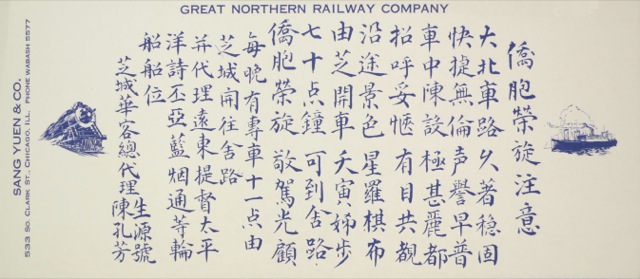
James J. Hill always saw his railroad as a route to the Orient, which is why he named his top train the Oriental Limited and for a time used a red solid circle–an Asian logo reminiscent of the yin-yang used by the Northern Pacific–on the rear drumhead for the train (later modified into a white mountain goat on a red circle). Thus, it isn’t too surprising to see a Great Northern blotter in Chinese.
According to one on-line source, Sang Yuen were “Importers and wholesalers Chinese general merchandise. Chop Suey supply a specialty. Chin Kung Fong, manager, and president of Joy Yen Lo Co., Chinese Restaurant. Wabash 5577.” Chin Kung Fong’s name isn’t on this blotter, but it appears on a GN blotter issued a year or two later.
This blotter advertises the fact that the Great Northern purchased 30 new steam locomotives in 1923 for a total of $2.5 million. These would be GN class Q1, 2-10-2 locomotives, known as “Santa Fe” engines because that railroad was the first to use a 2-10-2. The GN’s locos were built by Baldwin with 63-inch drivers and, with 210-pound boilers, were calculated to produce more than 87,000 pounds of tractive effort, which is huge for a non-articulated locomotive. The Santa Fe’s own most-powerful Santa Fes produced under 85,500 pounds of tractive effort.

Click image for a larger view; this picture is taken from the GN’s brochure on steam locomotives.
A few years before this, GN had ordered some 4-8-2 locomotives from Lima to pull its passenger trains. With just 62-inch diameter drivers, these class P1 locomotives proved to be too slow for passenger service and GN replaced them with class P2 4-8-2s built by Baldwin that had 73-inch drivers. Meanwhile, it rebuilt the Lima-built 4-8-2s into class Q2 2-10-2s.
